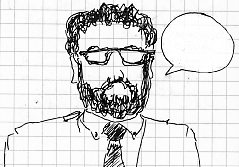Thursday, June 29, 2006
Recent Reading

I am pleased to report that Mortlake still stands, though its environs have certainly been tested by the rains and the Schuylkill river.
During the intermittent moments when flood and storm have rendered me study-bound, I've been reading Alice Quinn's edition of Elizabeth Bishop's juvenilia and uncollected poems, drafts, and notes titled Edgar Allan Poe & The Juke Box, (Farrar Straus and Giroux, 2006).
Although the publication of writing that (the famously perfectionist) Bishop preferred not see the light of day has been controversial in some quarters, the book has been a revelation to me.
In his piece on the collection in the April 27th edition of the New York Review of Books, Charles Simic summed it up pretty well:
Unlike just about every other poet whose collected poems are bound to contain embarrassments, [Bishop] never published a bad poem. As she told an interviewer, she was prepared to wait forty years for a poem to get finished since no good poet can afford to be in a rush. Such extraordinary patience is a standard not many of us are able to emulate. The publication of her uncollected poems, drafts, and fragments, which most certainly would have mortified her if she were still alive, solves a few puzzles and deepens others. As far as her reputation as a poet goes, these 106 flawed and at times marvelous poems will only enhance it. This would not be true of most other poets, but Bishop is a special case. Determined as she was that every poem of hers should surprise the reader with something new, she rarely wrote the same kind of poem twice.On a personal note, the painstaking way that Bishop crafted, edited, and revised her exquisite poems, a process which produced copious documentary evidence, kind of makes her a historian's poet.
This collection includes photo-reproductions of the sixteen extant typed and hand-written drafts Bishop wrote of her marvelous poem "One Art," and of equal artistic, biographical, and documentary interest are her three pages of typed notes for a never-finished "Elegy" about Lota de Macedo Soares.
Thursday, June 22, 2006
Alison Bechdel, II
Alison Bechdel's Fun Home, (Houghton Mifflin, 2006) has certainly caused a well-deserved stir. (There are links to recently-appearing reviews available at Bechdel's blog.)
There are several things that make Fun Home notable:
(1) It's being (widely) discussed as a "graphic novel," but like Marjane Satrapi's Persepolis, David B.'s Epileptic, and Miriam Katin's We Are On Our Own, it's actually a graphic memoir. Widespread discussion of these sometimes confining and problematic categories, and how and why they exist, is a good thing. (For example, the other night I got into a discussion with someone I had just met about why Fun Home and the Katin memoir were being shelved with graphic novels in the Barnes and Noble.)
(2) For a graphic work, Bechdel's book is immensely literary. Allusions to a wide body of written texts are woven into the book, and, consequently, Fun Home provides a multi-layered, engaging, and rich reading experience.
(3) It's marvelously good.
Bechdel provides the reader with a non-linear exploration of the experiences, memories, and retrospective moments of reflection and self-discovery which forged her development into the artist capable of making the text in your hands. (Joyce's A Portrait of the Artist is a touchstone.) And while I suppose all memoirs do this, the sensation of recognizing this was especially acute for me as I read Fun Home.
Here's my favorite page in the book, which brings chapter five to a close. (For various reasons, young Alison is dictating her diary entries to her mother.)
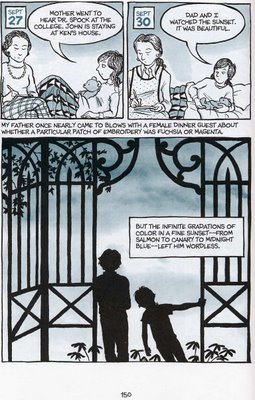
Alison Bechdel will be speaking at 7PM tonight at the Free Public Library this evening in Philadelphia. (1901 Vine Street)
There are several things that make Fun Home notable:
(1) It's being (widely) discussed as a "graphic novel," but like Marjane Satrapi's Persepolis, David B.'s Epileptic, and Miriam Katin's We Are On Our Own, it's actually a graphic memoir. Widespread discussion of these sometimes confining and problematic categories, and how and why they exist, is a good thing. (For example, the other night I got into a discussion with someone I had just met about why Fun Home and the Katin memoir were being shelved with graphic novels in the Barnes and Noble.)
(2) For a graphic work, Bechdel's book is immensely literary. Allusions to a wide body of written texts are woven into the book, and, consequently, Fun Home provides a multi-layered, engaging, and rich reading experience.
(3) It's marvelously good.
Bechdel provides the reader with a non-linear exploration of the experiences, memories, and retrospective moments of reflection and self-discovery which forged her development into the artist capable of making the text in your hands. (Joyce's A Portrait of the Artist is a touchstone.) And while I suppose all memoirs do this, the sensation of recognizing this was especially acute for me as I read Fun Home.
Here's my favorite page in the book, which brings chapter five to a close. (For various reasons, young Alison is dictating her diary entries to her mother.)

Alison Bechdel will be speaking at 7PM tonight at the Free Public Library this evening in Philadelphia. (1901 Vine Street)
Monday, June 19, 2006
Open Questions
Here's a list of my current comic book questions; I'd appreciate any thoughts readers might offer to help fuel my random speculations.
(1) Will Selina Kyle again be Catwoman?
—(a) Will Holly Robinson need to die for this to happen?
—(b) Will Helena (Dubrovna) Kyle need to die for this to happen?
—(c) Will Helena's baby-sitter Miranda, introduced in issue #55, turn out to be a psycho-baby-killer?
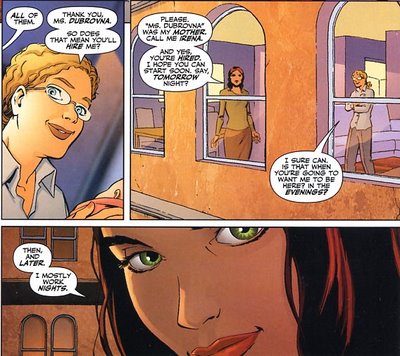
Although I wish Holly Robinson unmitigated success as she takes up the mantle of Catwoman, it must be said that, whether Selina Kyle is in costume or not, she simply is Catwoman, for me.
The most important question: can a woman be a single mother and a costumed adventurer? (Kate Spencer in Manhunter would seem to provide a relevant precedent to how this could possibly play out.)
(2) Following Brian Michael Bendis' advice, (which I discussed here), DC has engaged in a project to humanize Wonder Woman: will the moves taken to do this strengthen, or irrevocably ruin, the character?
(3) Will Cassandra Cain be a permantent villain, or is the person we're seeing in recent issues of Robin brain-washed, mentally unstable, or an evil twin/clone?
(4) Will Spider-Girl actually end with Spider-Girl's end?
(5) In the alternate time-stream depicted in the "Absolute Power" story-line from Superman/Batman, Superman murdered that universe's version of Wonder Woman. Shouldn't he be held accountable for that crime in some way?
(6) When, how, and in what book will Dr. Light be brought to justice?
Finally, two Reed Richards observations from Civil War #2:
(1) Reed's treatment of his wife Sue actually surpassed the Doom Patrol's Niles Caulder's astounding exchange with Rita Farr in Teen Titans #36 ("You follow my orders ... and maybe one day you won't be a freak anymore ..."), to top my list of the most starkly misogynistic situation set into motion by a non-villain. Now, I know both exchanges were purposefully written this way, but Reed's dickery in CW #2 seems so extreme that pulling the character back from it may not be possible. And, as Heidi Meeley argues here, perhaps that's the whole point.
(2) If Reed is so smart, why doesn't he know that you just can't reduce something as complex as the outcome of unrestricted superhuman activity to a series of formulae? I'm sorry, but no matter how smart you are, no matter how long and complex the formulae might be, this just can't be reliably done — and Mark Millar should know this.
(1) Will Selina Kyle again be Catwoman?
—(a) Will Holly Robinson need to die for this to happen?
—(b) Will Helena (Dubrovna) Kyle need to die for this to happen?
—(c) Will Helena's baby-sitter Miranda, introduced in issue #55, turn out to be a psycho-baby-killer?

Although I wish Holly Robinson unmitigated success as she takes up the mantle of Catwoman, it must be said that, whether Selina Kyle is in costume or not, she simply is Catwoman, for me.
The most important question: can a woman be a single mother and a costumed adventurer? (Kate Spencer in Manhunter would seem to provide a relevant precedent to how this could possibly play out.)
(2) Following Brian Michael Bendis' advice, (which I discussed here), DC has engaged in a project to humanize Wonder Woman: will the moves taken to do this strengthen, or irrevocably ruin, the character?
(3) Will Cassandra Cain be a permantent villain, or is the person we're seeing in recent issues of Robin brain-washed, mentally unstable, or an evil twin/clone?
(4) Will Spider-Girl actually end with Spider-Girl's end?
(5) In the alternate time-stream depicted in the "Absolute Power" story-line from Superman/Batman, Superman murdered that universe's version of Wonder Woman. Shouldn't he be held accountable for that crime in some way?
(6) When, how, and in what book will Dr. Light be brought to justice?
Finally, two Reed Richards observations from Civil War #2:
(1) Reed's treatment of his wife Sue actually surpassed the Doom Patrol's Niles Caulder's astounding exchange with Rita Farr in Teen Titans #36 ("You follow my orders ... and maybe one day you won't be a freak anymore ..."), to top my list of the most starkly misogynistic situation set into motion by a non-villain. Now, I know both exchanges were purposefully written this way, but Reed's dickery in CW #2 seems so extreme that pulling the character back from it may not be possible. And, as Heidi Meeley argues here, perhaps that's the whole point.
(2) If Reed is so smart, why doesn't he know that you just can't reduce something as complex as the outcome of unrestricted superhuman activity to a series of formulae? I'm sorry, but no matter how smart you are, no matter how long and complex the formulae might be, this just can't be reliably done — and Mark Millar should know this.
Sunday, June 18, 2006
Fathers
Walking Home
By Gjertrud Schnackenberg
Walking home from school one afternoon,
Slightly abstracted, what were you thinking of?
Turks in Vienna? Luther on Christian love?
Or were you with Van Gogh beneath the moon
With candles in his hatband, painting stars
Like singed hairs spinning in a candle flame?
Or giant maps where men take, lose, reclaim
Whole continents with pins? Or burning cars
And watchtowers and army-censored news
In Chile, in the Philippines, in Greece,
Colonels running the universities,
Assasinations, executions, coups —
You walked, and overhead some pipsqueak bird
Flew by and dropped a lot of something that
Splattered, right on the good professor, splat.
Now, on the ancient Rhine, so Herod heard,
The old Germanic chieftains always read
Such droppings as good luck: opening the door,
You bowed to improve my view of what you wore,
So luckily, there on the center of your head.
Man is not a god, that's what you said
After your heart gave out, to comfort me
Who came to comfort you but sobbed to see
Your heartbeat zigzagging on a TV overhead.
You knew the world was in a mess, and so,
By God, were you; and yet I never knew
A man who loved the world as much as you,
And that love was the last thing to let go.
— In Gjertrud Schnackenberg, Supernatural Love: Poems 1976-1992, (Farrar Straus and Giroux, 2000), p. 9
By Gjertrud Schnackenberg
Walking home from school one afternoon,
Slightly abstracted, what were you thinking of?
Turks in Vienna? Luther on Christian love?
Or were you with Van Gogh beneath the moon
With candles in his hatband, painting stars
Like singed hairs spinning in a candle flame?
Or giant maps where men take, lose, reclaim
Whole continents with pins? Or burning cars
And watchtowers and army-censored news
In Chile, in the Philippines, in Greece,
Colonels running the universities,
Assasinations, executions, coups —
You walked, and overhead some pipsqueak bird
Flew by and dropped a lot of something that
Splattered, right on the good professor, splat.
Now, on the ancient Rhine, so Herod heard,
The old Germanic chieftains always read
Such droppings as good luck: opening the door,
You bowed to improve my view of what you wore,
So luckily, there on the center of your head.
Man is not a god, that's what you said
After your heart gave out, to comfort me
Who came to comfort you but sobbed to see
Your heartbeat zigzagging on a TV overhead.
You knew the world was in a mess, and so,
By God, were you; and yet I never knew
A man who loved the world as much as you,
And that love was the last thing to let go.
— In Gjertrud Schnackenberg, Supernatural Love: Poems 1976-1992, (Farrar Straus and Giroux, 2000), p. 9
Friday, June 16, 2006
Bloomsday, 2006
At Mortlake, June 16th is revered as the day in which the action of James Joyce's novel Ulysses (1922) took place.
Ulysses is my must have if-stranded-on-a-desert-island book.
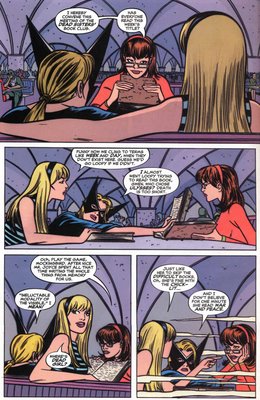
Others, of course, are free to disagree with my personal assessment. (Especially deceased superheroes.)
The image is from X-Statix Presents: Dead Girl #2.
Ulysses is my must have if-stranded-on-a-desert-island book.

Others, of course, are free to disagree with my personal assessment. (Especially deceased superheroes.)
The image is from X-Statix Presents: Dead Girl #2.
Tuesday, June 13, 2006
Character Driven
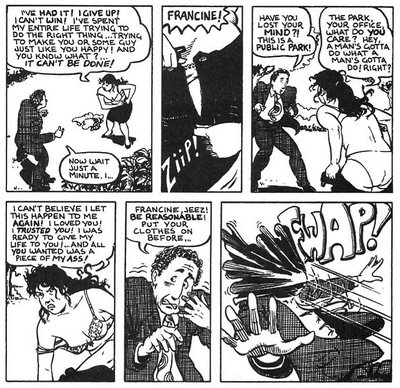
There's an interesting and wide-ranging interview with Terry Moore, creator of Strangers in Paradise, in The Comics Journal #276. (A small portion of the interview is available online, here.)
Moore sensitively discusses his growth as an artist and writer throughout the interview, and describes a personal "road to Damascus" moment he had while conceptualizing the series.
Dirk Deppey: I noticed that in your last Journal interview, you mentioned that you thought the original four-issue miniseries was sexist, and I'm not sure I got why that was. Do you still think that's the case, and if so, why?That's a subtle, but important, distinction to make. Here's how Moore completes the thought:
Terry Moore: I think maybe it just felt more sexist to me, because I was writing about women doing things I wanted them to do. When I was plotting the regular series, I knew I wasn't going to write like that anymore. I was going to write about what my characters wanted to do, not what I wanted them to do.
Moore: The entire miniseries was based off of one idea, this scene of a woman taking off her clothes in the park; which I thought was just a charming moment I'd love to see in a movie, you know? But it was for me. To write the rest of the miniseries I just did a detective routine from there — "OK, what would make a regular woman do that, because that's unthinkable, and how did she get to that point?" It was kind of like a writer's challenge, you know, catch a moving train and then figure out how everybody got there and where they're going. That's what I did with the story I just kind of wrote forward and backwards from the park scene.Later in the interview, Moore nicely clarifies his relationship to his characters.
Deppey: I hear a lot of cartoonists refer to their characters as though they were real people, and I guess that has something to do with the fact that you've just been sitting there and living them for the past 10 years, and working out their motivations.
Moore: I really don't think you can write a story worth reading without thinking of your characters as real people. It was a turning point in my life when I realized that. Before that, I never made anything worth reading when I was just trying to make up characters. When I stopped thinking about it like that, and just started writing about people, that's when my whole life changed. That's when I came up with SiP. So I've kept that approach ever since.
Monday, June 12, 2006
Wonder Woman #1
When I was a teenager, I loved New Wave movies because they featured crazy camera shots and exciting quick cuts. As I got older, though, my favorite filmakers turned out to be pre-New Wave directors like Jean Renoir, because they really focused on the actors, and what the acting itself communicated to the audience... . — Austin English, in a "Bullets" review of Vanessa Davis' Spaniel Rage, in The Comics Journal #176, pp. 56-7.(Spoilers follow in abundance.)
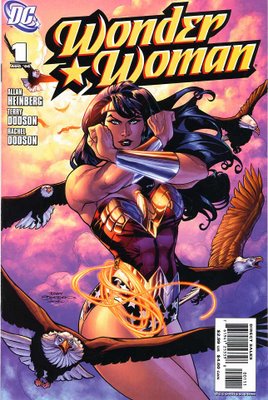
Wonder Woman #1 looks marvelous. Terry Dodson's assured pencilling is perfectly complemented by Rachel Dodson's inking and Rob Leigh's masterful coloring. The comic now has a visual depth and complexity that it lacked under previous teams, with individual panels and pages offering multiple points of focus and and perspective.
For example, these two panels, showing nothing more than acting Wonder Woman Donna Troy's entry into the Museum of Natural History, (which has an exhibit on Themyscira, The Lost Civilization of the Amazons), carefully bring together light effects, shading, background detail, and perspective to make things visually interesting.
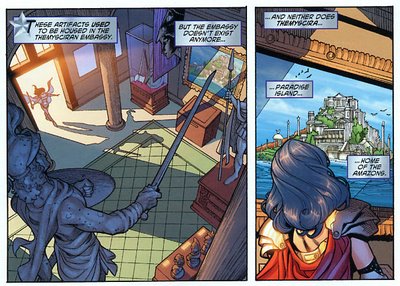
And the following two panels are quite nicely juxtaposed, especially since the departing Diana serves as a centering focus on the left, while Donna takes that position in the right panel. (And the visual cliché of the windswept leaves works in the first one, since they frame the image and reinforce the vertiginous perspective.)

Though it delivers visually, the issue doesn't quite keep pace with respect to story-telling, since the action primarily serves as a prologue, introducing the current Wonder Woman, her enemies, and the title's supporting players (one of whom, going by the name of Diana Prince, is dramatically revealed on the book's final page).
As I read the issue, I was reminded of the experience of seeing Star Wars when it was re-released in theaters a few years ago; the audience heartily applauded when each character made their first screen appearance, and full-page spreads here serve to elicit a similar response, getting us to cheer (or hiss) when important figures first take the stage.
In short, I was left wanting more when I finished issue #1, and felt that the seeds of an interesting story-line with strong characterization have been planted and await future development.
Surprisingly, it seems possible that we might get a story-arc that's as much about Donna Troy as it is about Diana of Themyscira. For, although Donna's encounter with a cabal of formidable adversaries does not go exactly swimmingly, I can't imagine that Allan Heinberg intends to allow a villain's one-liner to encapsulate his own characterization of Donna Troy. (To Donna's You-- you're not Wonder Woman, the villain replies: With all due respect ... neither are you.)
At this point, I have to admit that I'm actually less interested in who Wonder Woman is, than I am in learning why Diana felt the need to take a 52 week vacation, and how her absence has affected her relationships with Donna Troy, Cassandra Sandsmark, and other individuals in the DCU.
To extend the film metaphor: when it comes to Wonder Woman, I prefer a character-based director's film to a less-nuanced action blockbuster.
Thursday, June 08, 2006
Miriam Katin, II
We Are on Our Own, Miriam Katin's new memoir from Drawn & Quarterly, is a difficult, beautiful, and compelling book. Katin is a humane and talented artist whose layered pencilling style makes her depictions of her extraordinary life experiences accessible to the reader.
In a note at the end of the book she writes:
While answering questions at the Rittenhouse Square Barnes and Noble yesterday evening, Katin self-deprecatingly described herself as an illustrator rather than as an artist, with her explanation being that this was fitting since she had received no formal artistic education.
Reading her remarkable work, I have to admit that the distinction utterly eludes me.

In a note at the end of the book she writes:
This book is the story of our escape and hiding during the year of 1944-1945. I could somehow imagine the places and the people my mother told me about, but a real sense of myself as a small child and the reality of the fear and confusion of those times I could understand only by reading the last few letters and postcards my mother had written to my father. They survived the war with him.
While answering questions at the Rittenhouse Square Barnes and Noble yesterday evening, Katin self-deprecatingly described herself as an illustrator rather than as an artist, with her explanation being that this was fitting since she had received no formal artistic education.
Reading her remarkable work, I have to admit that the distinction utterly eludes me.

Wednesday, June 07, 2006
Miriam Katin
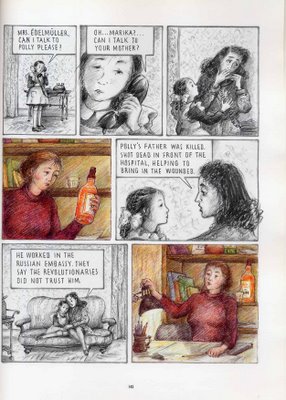
As part of the First Person Arts Festival, Miriam Katin will be speaking about her graphic memoir We Are on Our Own tonight in Philadelphia. (Barnes and Noble, 1805 Walnut Street at 7PM.)
Here's D&Q's brief description of the memoir:
In this captivating and elegantly written graphic memoir, Miriam Katin retells the story of her and her mother's escape on foot from the Nazi invasion of Budapest. With her father off fighting for the Hungarian army and the German troops quickly approaching, Katin and her mother are forced to flee to the countryside after faking their deaths. Unable to tell anyone of their whereabouts, they disguise themselves as a Russian servant and illegitimate child, while literally staying a few steps ahead of the German soldiers.
Several years ago I read Katin's marvelous short piece "Oh, To Celebrate!" which appeared in Drawn & Quarterly volume 4, (D&Q, 2001). (The image is from that story.)
Based on the strength of that work, I'm looking forward to reading the memoir, and to seeing her presentation this evening.
Monday, June 05, 2006
Alison Bechdel
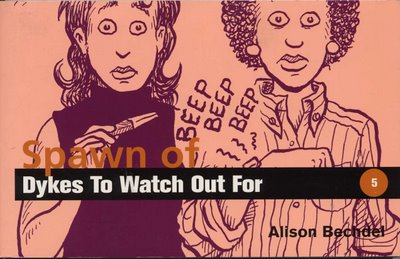
Alison Bechdel is a masterful cartoonist who has been producing her award-winning strip Dykes to Watch Out For since 1983. (The image is the cover to the fifth collection of strips, published in 1993 by Firebrand Books.)
Her insightful, well-wrought, and literate graphic memoir Fun Home: A Family Tragicomic, (Houghton Mifflin), has just been published, and I can't recommended it highly enough. I just finished reading the book over the weekend, and plan to post more about it once I've spent some more time with it and have given it additional thought.
Margot Harrison's recent article ("Life Drawing") from Seven Days: Vermont's Alternative Webweekly, provides an interesting exploration of Bechdel's creative career, as well as an assessment of the memoir.
The Comics Journal has a 2001 Bechdel interview, conducted by Trina Robbins, available online, and while it provides ample evidence that Bechdel is engaging and funny, (two things readers of her strip already know), we also learn that Fun Home was developing in her mind for quite some time.
Robbins: Let's start by having you tell us what you're working on now.
Bechdel: Well, I'm always working on my comic strip and trying to, you know, keep cranking that out. I've been trying to sort of make that my day job, which has been a huge struggle because...
...
I'm trying to make time in my life to work on a graphic memoir. Although, at the rate I'm going, it'll take forever to finish.
...
[T]here was something else going on for me as a kid, something about my gender identity that I haven't figured out yet. And that's one of the things I'm hoping to dissect and investigate in this memoir project.
But mostly, it's a book about my relationship with my father. Writing this book feels like a completely different activity from writing my comic strip because it's about real life. I feel like I'm using a part of my brain that's been dormant until now.
And here's Bechdel describing work that has inspired her:
Bechdel: I never really read superhero stuff as a kid. I'm pretty illiterate when it comes to comics history. Some Little Nemo, some Krazy Kat, that's it.This is one lesson Bechdel's learned well; the way her writing and drawing complement one another is part of what makes reading her comics such a treat.
Robbins: Oh, wow, yeah. So what's your inspiration then? You couldn't have just sprung from an oyster shell or something.
Bechdel: Mostly it was Mad magazine. And I did read a lot of -- I had a subscription when I was little, but I also had access to some old collections, the little paperbacks of the really good stuff.
Robbins: Yes. Mad. They were the best. I also see Jules Feiffer in your work.
Bechdel: I love Jules Feiffer. I didn't discover him until I was a little older. But I read comic books. I read things like Richie Rich and Little Lulu. I had a big box of classic comics up in the attic that my dad got from an antique show. But I don't feel like the comic books, the Richie Rich and Little Lulu stuff really shaped my work in a substantive way, except to maybe teach me basic visual grammar. The satiric ethos of Mad was a much bigger childhood influence. That and Charles Addams. I discovered his stuff before I could read, and was mesmerized by it. It was so frustrating because I thought I'd be able to understand these cartoons when I learned to read the captions, but they were still a complete mystery. I'd look at them for hours, trying to figure out what the joke was. I think I learned my biggest cartooning lesson from Addams -- how to calibrate that crucial, tantalizing distance between the image and the words. Not too wide, not too narrow - just enough for the reader to complete the circuit.
Friday, June 02, 2006
Disaster Averted!
In a piece up at Newsarama, Dan DiDio has announced the un-cancellation of Manhunter. Although the promise of renewed life extends only to a five issue story arc, there's hope for a more permanent revival.
This is very welcome news.
Here's what DiDio said, in the heart of the article:
This is very welcome news.
Here's what DiDio said, in the heart of the article:
"We're creating an arc that will run another five issues, and we're hoping that there will be a groundswell of excitement from the fan base that will help drive the sales and push them up, and help this book keep going from there," Didio explained.Now that the gauntlet's been thrown down, I eagerly await a reciprocal announcement from Joe Quesada about Spider-Girl.
...
"We're making the official announcement at the DC Nation panel at WizardWorld this weekend, and here, right now," Didio said when asked how he's going to make sure the word reaches all ears. "I'll also be dedicating one of my weekly DC Nation columns to the return of Manhunter, and one of the things we're all going to do is make sure we take every opportunity we can to get things right. We're looking at the book coming back in October or November, depending on how quickly our plans come together, and we'll make sure we'll have some promotion tied to those five issues when they're coming out."
Thursday, June 01, 2006
Re-Launching Wonder Woman
Bliss was it in that dawn to be alive,
But to be young was very Heaven!
— William Wordsworth, The Prelude, Bk 11
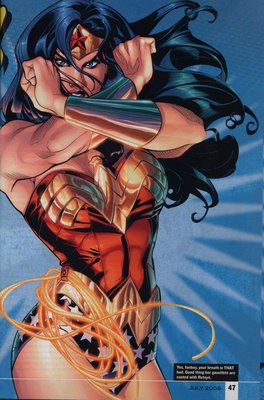
Wizard #177 has got a hefty four page article on the history of Wonder Woman, including an exclusive review of Allan Heinberg's script for the upcoming first issue. (Ben Morse, "Wonder of the World," pp. 46-49.)
The review's sub-header provides the gist of the magazine's coverage:
Allan Heinberg's Script Delivers the Best Amazon Princess We've Ever Read
Choice excerpts from the script review:
The first issue packs in character moments, action, big villains and mystery into one tight, 22-page tale that leaves fans ravenous for the next issue.
Heinberg's script not only makes readers care about "Who is Wonder Woman?" (the title of the first arc), it also elevates her villains to a more menacing level and begins building a suitable supporting cast.
Tying in the recent events of Infinite Crisis and Princess Diana's execution of Maxwell Lord a year ago, the book centers on who currently holds the mantle of Wonder Woman (it's not who you think), and what the world thinks of the idea of Wonder Woman. ...
More than anything else, the book makes the reader care as much about Wonder Woman and her role in the new DC Universe as they do about Superman — a view she's always had from the back seat. Her villains — we're talking the big ones — impressively loom as threatening as Batman's rogues. ...
The article serves as an extended message to Wizard readers and fanboys everywhere, informing them that it's safe for them to climb aboard the relaunched book. Further evidence of this is provided in the "Picks of the Month" section of the magazine, where Wonder Woman #1 gets the "Spotlight On ..." treatment, and is again discussed in the most glowing terms possible. (p. 112)
Though all systems appear to be "go," with this, there was a subtext to the coverage that bugged me, though.
I want to make clear that my unease was not sparked by anything Allan Heinberg said. To the contrary, his comments in the magazine show how committed he is to the character's past as he works to shape her future. In addition, he provides this marvelous, one-sentence description of the first issue:
"Wonder Woman #1 is an intimate character study disguised as a widescreen, action packed superhero epic."
So what did annoy me? Well, there's no getting past the fact that with its frequent mention of the book's amped-up super-villains and committment to action, the article could easily have been subtitled:
Guys, it's OK to read the new Wonder Woman, it's not just for girls anymore.
